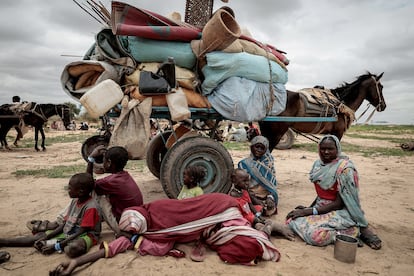Sudan: Seven drivers of a ‘humanitarian crisis of epic proportions’
The civil war that has been devastating the African country for almost a year has produced the largest number of internally displaced individuals in the world and a famine emergency affecting five million people. It also looms as a regional conflict


There are more than 12,000 dead, more than eight million people displaced, an estimated 18 million are starving, and 25 million are in need of humanitarian aid. The civil war that broke out in Sudan on April 15, 2023, following a confrontation between the national army and the paramilitary Rapid Support Forces (RSF), has sparked a human catastrophe that has turned this northeastern African nation into the world’s largest internally displaced population crisis and is plunging it into the “largest hunger crisis,” according to the World Food Program (WFP).
The consequences of war in a country that is slightly larger than the combined size of Spain, Portugal, France, Italy and Germany “will also create disturbances” in the entire region. The neighboring countries, which are already strained to the limit, have had to provide refuge to nearly two million people fleeing the war, explains Mohammed Qazilbash, director general of Plan International Sudan, during a visit to Madrid.
These are the drivers of a conflict that, according to the United Nations, has caused a “humanitarian crisis of epic proportions”:
1. The “largest hunger crisis”
Approximately five million Sudanese, 10.4% of a population of 48 million, are in emergency or Phase 4 of the Integrated Food Security Phase Classification (IPC), the tool that measures food security worldwide. This is the level that precedes the declaration of famine, or Phase 5. In addition, almost 13 million are in Phase 3 or emergency, which means that close to 18 million people (about 37%) are experiencing hunger in Sudan. The WFP executive director, Cindy McCain, warned earlier this month that the war in the country could spark “the world’s largest hunger crisis.”
The conflict has directly disrupted food production, which had already been hampered by the drought in North Africa. However, in addition, “with so many millions of displaced people, farmers have not been able to plant seeds,” says Qazilbash. And even if they had attempted to, “the agricultural sector in Sudan is heavily subsidized by the government, which finances supplies such as fertilizers, but with the collapse of the executive all these subsidies have disappeared.”
“There’s food in the market, but it is simply unaffordable for most families, due in part to a continued telecommunications blackout that is preventing families from receiving much needed mobile cash,” Jill Lawler, UNICEF’s Chief of Field Operations and Emergency in Sudan, who visited the country in early March, explains in a statement. “There is nothing, no internet, no banks, no money,” confirms the Sudanese artist Eltayeb Daw Elbait, exiled in Kenya, during a visit to Madrid, where he is participating in an exhibition, after several months of unsuccessfully trying to send money to his relatives who are still in Sudan.
2. Nearly four million children malnourished and 19 million out of school
According to UNICEF’s estimates, nearly 3.7 million children are projected to be “acutely malnourished this year” in Sudan. “At a hospital we visited, we saw malnourished children and their caregivers in total darkness because of electricity outages,” explains Jill Lawler, after her visit to Sudan.
“Malnutrition in children under five years of age is especially concerning because if the right level of nutrition is not maintained at that age for their mental and physical development, when they become adults they may have physical and intellectual consequences,” bemoans Qazilbash. “How can you build a nation that has an intellectually and physically compromised future?” asks the director of Plan International Sudan.
The humanitarian worker goes on to say, “schools have been closed for almost a year, which means that 19 million children are out of school.” “This is another catastrophe,” he points out.
3. The largest number of internally displaced individuals
More than eight million people have been forced to flee their homes in Sudan since the civil war broke out on April 15, 2023, according to U.N. data. Of these, some two million Sudanese have sought refuge in bordering countries. The six million who have been displaced within the country join another three million from previous conflicts, who have been unable to return owing to the continued deteriorating security situation. “One in eight of the world’s internally displaced persons is Sudanese,” says the U.N., which means the country has the “world’s largest displacement crisis.”
“The civil war has caused widespread displacement of people and, as with any displacement, women and children are the most affected,” warns Qazilbash. With four million children displaced, “it is also the global crisis that has caused the highest level of displacement of children in the world,” he regrets.
4. Spread of a regional crisis
Of the almost two million Sudanese who have fled the country, 37% have taken refuge in Chad, 30% in South Sudan and 25% in Egypt, according to the International Organization for Migration (IOM). “This is not a crisis in Sudan, but a regional crisis, and though Sudan is the epicenter, all the surrounding countries are dealing with the aftershocks,” Qazilbash points out. He adds: “Before this crisis, Chad, for instance, was not very prosperous, it was a poor country with numerous internal and external problems, and now it has more than half a million Sudanese living on its eastern border.” For that reason, Qazilbash says, “not only must the needs within the country be covered, but all emergency situations of externally displaced persons must also be addressed.”

5. Murder, rape and looting
“The human rights situation in Sudan remains out of control,” warn U.N. sources. “Thousands of civilians have been killed, millions displaced, looted property and children recruited,” adds the latest report on the situation in the African country, in which the U.N. states that “some of these violations would amount to war crimes.”
There is particular concern in the Darfur region (to the west of the country), where humanitarian access has not been possible for months, according to the U.N. “Thousands of people were killed in RSF attacks, some of them were ethnically motivated,” sources within the organization say.
6. The collapse of healthcare services
Hostilities during almost a year of war “have left more than 25% of all hospitals nonfunctional” while “the main national laboratory” has been occupied by fighters, explained sources from the World Health Organization (WHO) Regional Directorate in Sudan. The large number of displaced persons, together with the collapse of the healthcare services, “led to outbreaks of diseases such as cholera, measles, malaria and dengue fever,” according to the same organization. At Al Nao in Omdurman (near Khartoum, the capital), “we saw two, sometimes three patients, sharing beds,” says Lawler. The director of this hospital confirmed to UNICEF that, “about 300 people had limbs amputated in the hospital in just the past month alone.”

“Exhaustion among staff — many of whom are practically living in the hospital, and most of whom have not been paid regular salaries in months — is palpable, as is frustration at the lack of supplies, equipment and space,” says UNICEF’s Chief of Field Operations in Sudan.
7. Humanitarian aid, “a drop in the ocean”
More than 25 million people, including 14 million children, require humanitarian assistance in the country, according to U.N. data. “Humanitarian aid enters Sudan, but on a scale too small to reach the millions of Sudanese living in refugee camps or in their own homes,” says Qazilbash. “Thousands of tons of food would be needed to cover the food necessities alone, so if only two trucks a day arrive, humanitarian aid is a drop in the ocean,” continues the humanitarian worker, who calls for a “stop to hostilities” to allow the arrival of aid to be effective.
The United Nations Office for the Coordination of Humanitarian Affairs (OCHA) Humanitarian Response Plan 2024 for Sudan has so far secured 5% of the $2.7 billion it estimates is needed to cover food, medical care, supplies and other critical life-saving assistance throughout this year.
Despite the fact that considerably less than what is needed is arriving, it is extremely difficult to get this aid into the country. The U.N. confirms that, “humanitarian access is limited by the complex dynamics of the conflict, including the constant shifting of fronts as fighting spreads to new areas.” “Aid convoys face threats, roadblocks, restrictions and bureaucratic impediments, making it extremely difficult for WFP to expand its assistance,” international agency sources believe, who also call for “freedom of movement across borders and conflict lines to reach all vulnerable communities, regardless of where they are located.”
Sign up for our weekly newsletter to get more English-language news coverage from EL PAÍS USA Edition
Tu suscripción se está usando en otro dispositivo
¿Quieres añadir otro usuario a tu suscripción?
Si continúas leyendo en este dispositivo, no se podrá leer en el otro.
FlechaTu suscripción se está usando en otro dispositivo y solo puedes acceder a EL PAÍS desde un dispositivo a la vez.
Si quieres compartir tu cuenta, cambia tu suscripción a la modalidad Premium, así podrás añadir otro usuario. Cada uno accederá con su propia cuenta de email, lo que os permitirá personalizar vuestra experiencia en EL PAÍS.
¿Tienes una suscripción de empresa? Accede aquí para contratar más cuentas.
En el caso de no saber quién está usando tu cuenta, te recomendamos cambiar tu contraseña aquí.
Si decides continuar compartiendo tu cuenta, este mensaje se mostrará en tu dispositivo y en el de la otra persona que está usando tu cuenta de forma indefinida, afectando a tu experiencia de lectura. Puedes consultar aquí los términos y condiciones de la suscripción digital.
More information
Archived In
Últimas noticias
There is as much life left to discover on planet Earth as that which is already known
Dozens presumed dead, around 100 injured in fire at Swiss Alps bar during New Year’s celebration
Is porn for women different from conventional porn? We spoke to those who make it
Cartagena de Indias is sinking: What can the city do to mitigate it?
Most viewed
- David King, chemist: ‘There are scientists studying how to cool the planet; nobody should stop these experiments from happening’
- Reinhard Genzel, Nobel laureate in physics: ‘One-minute videos will never give you the truth’
- Oona Chaplin: ‘I told James Cameron that I was living in a treehouse and starting a permaculture project with a friend’
- Sinaloa Cartel war is taking its toll on Los Chapitos
- The Interoceanic Train, the Mexican alternative to the Panama Canal










































